For drum kit, arm-sensors, live-electronics and live-video
The use of sensors at the forearm of the player allows the complete control of the live electronics and the structuring of the piece. Furthermore the player's movement is the exclusive material for the live video.
Based on these technical possibilities I tried to realize a piece that works like a huge convolution. The acoustically played material is temporarily shifted, processed and then interweaved through the motions of the performer. Apart from this sound synthesis is playable with the sensors to extend the musical language of the drum set. But the idea is that both the processed sounds and the additional elements are all controllable by and hence linked to the movement of the player - focusing the generation of sound as much on the physical presence of the player as possible. The pyramiding of sound shreds, live-electronics and the percussion itself aims at a highly condensed performance somewhere between contemporary classical music and electronica.
The title of the piece is inspired by the "laplace demon" - a thought experiment describing a model using total determination. This is to evoke the question of how a system of this complexity is totally reproducible - which it is not in this case. The concept of the piece is a very structured progression of about 100 scenes, which are clearly defined - but within these cells there is a great amount of freedom for the performer on a micro level. This allows the interpreter to react to and play with the fine details and nuances arising from slight gestures and to have the freedom to develop the interlacing between the acoustic drumming and the folded, temporarily shifted processing.
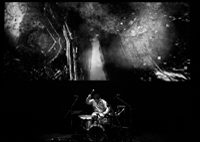
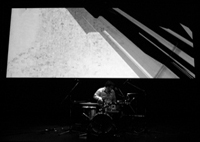
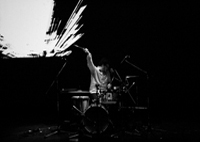
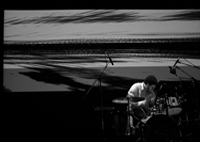
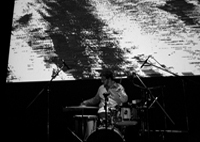
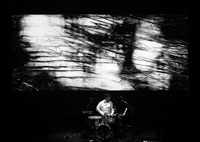
photos (c) Arely Arenas
Laplace Tiger (2009) 12'
Für Schlagzeug, Sensoren, Live-Elektronik und Live-Video
Die Verwendung der Sensoren an den Armen des Interpreten ermöglicht die vollständige Kontrolle der Live-Elektronik und Strukturierung des Stückes. Diese Bewegungen sind außerdem der Auslöser für das Live-Video.
Basierend auf dieser technischen Vorraussetzung wollte ich etwas realisieren, das wie eine große Faltung funktioniert: Das gespielte Material wird zeitlich versetzt mit der Bewegung des akustischen Instrumentenspiels verwoben - es wird zeitlich und in Bezug auf die Bewegung ineinander verschränkt. Doch auch die zusätzlichen Klänge und Genre-Elemente werden in das Spiel des Schlagzeugers mit integriert, so dass er in die Lage versetzt wird, diese über ein solistisches Repertoire hinausgehenden Versatzstücke mit zu steuern, aber vor allem zu integrieren. Das Verschachteln von Klangfetzen, der Perkussion selber und der Live-Elektronik, zusammengeführt in der Bewegung des Musikers, zu einem Resultat, das zwischen zeitgenössischer Musik und Electronica liegt, war es, was mich gereizt hat.
Der Titel, angelehnt an den "Laplace Dämonen" - ein Gedankenexperiment, das den vollständigen Determinismus veranschaulicht und anwendet - greift die improvisierte Natur des Stückes auf. Die herkömmliche Notation aller Parameter des Stückes, also der Steuerung mithilfe der Sensoren, wäre zwar machbar, aber würde in meinen Augen die Energie und von mir erhoffte Spielfreude und -spontanität behindern und wäre aufgrund der großen Anzahl von Einflussnahmen und nur bedingt vorhersehbaren Eigenschaften von kleinsten, live aufgenommen Klangschnippseln wenig effektiv. Es geht genau um das Zusammenspiel von einem im Ganzen stark strukturierten Stück, mit ca. 100 Unterregionen, und dem Spiel mit im kleinsten Detail nur im Allgemeinen vorhersagbaren Klangmanipulationen.
Mir dienen die Felder der mathematischen Integration und Faltung dabei schlicht als Sinnbild und wissenschaftlich pseudo-korrekte Beschreibung des Ineinanderklappens von Zeit, Bewegung und Stilistik.
Für Schlagzeug, Sensoren, Live-Elektronik und Live-Video
Die Verwendung der Sensoren an den Armen des Interpreten ermöglicht die vollständige Kontrolle der Live-Elektronik und Strukturierung des Stückes. Diese Bewegungen sind außerdem der Auslöser für das Live-Video.
Basierend auf dieser technischen Vorraussetzung wollte ich etwas realisieren, das wie eine große Faltung funktioniert: Das gespielte Material wird zeitlich versetzt mit der Bewegung des akustischen Instrumentenspiels verwoben - es wird zeitlich und in Bezug auf die Bewegung ineinander verschränkt. Doch auch die zusätzlichen Klänge und Genre-Elemente werden in das Spiel des Schlagzeugers mit integriert, so dass er in die Lage versetzt wird, diese über ein solistisches Repertoire hinausgehenden Versatzstücke mit zu steuern, aber vor allem zu integrieren. Das Verschachteln von Klangfetzen, der Perkussion selber und der Live-Elektronik, zusammengeführt in der Bewegung des Musikers, zu einem Resultat, das zwischen zeitgenössischer Musik und Electronica liegt, war es, was mich gereizt hat.
Der Titel, angelehnt an den "Laplace Dämonen" - ein Gedankenexperiment, das den vollständigen Determinismus veranschaulicht und anwendet - greift die improvisierte Natur des Stückes auf. Die herkömmliche Notation aller Parameter des Stückes, also der Steuerung mithilfe der Sensoren, wäre zwar machbar, aber würde in meinen Augen die Energie und von mir erhoffte Spielfreude und -spontanität behindern und wäre aufgrund der großen Anzahl von Einflussnahmen und nur bedingt vorhersehbaren Eigenschaften von kleinsten, live aufgenommen Klangschnippseln wenig effektiv. Es geht genau um das Zusammenspiel von einem im Ganzen stark strukturierten Stück, mit ca. 100 Unterregionen, und dem Spiel mit im kleinsten Detail nur im Allgemeinen vorhersagbaren Klangmanipulationen.
Mir dienen die Felder der mathematischen Integration und Faltung dabei schlicht als Sinnbild und wissenschaftlich pseudo-korrekte Beschreibung des Ineinanderklappens von Zeit, Bewegung und Stilistik.